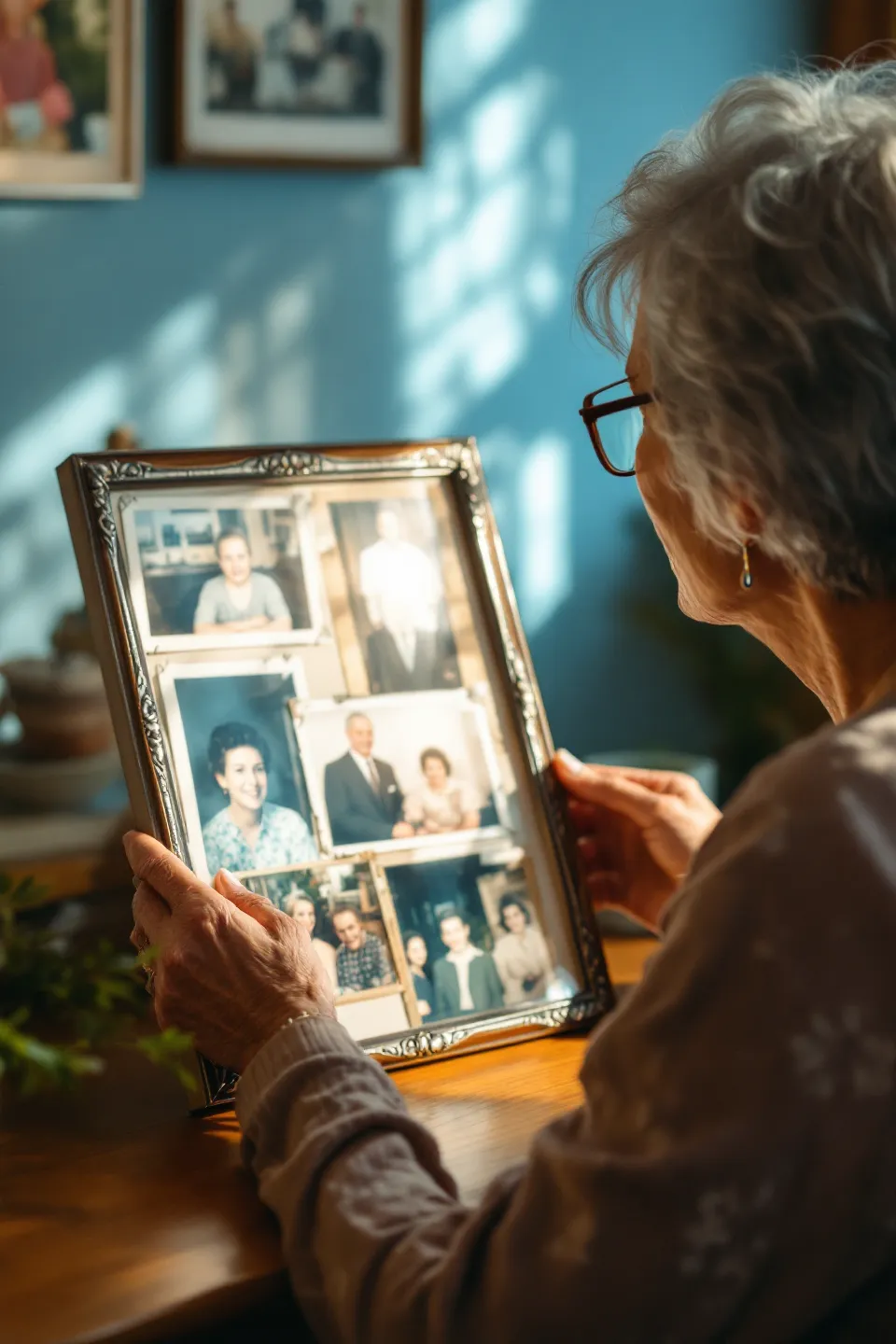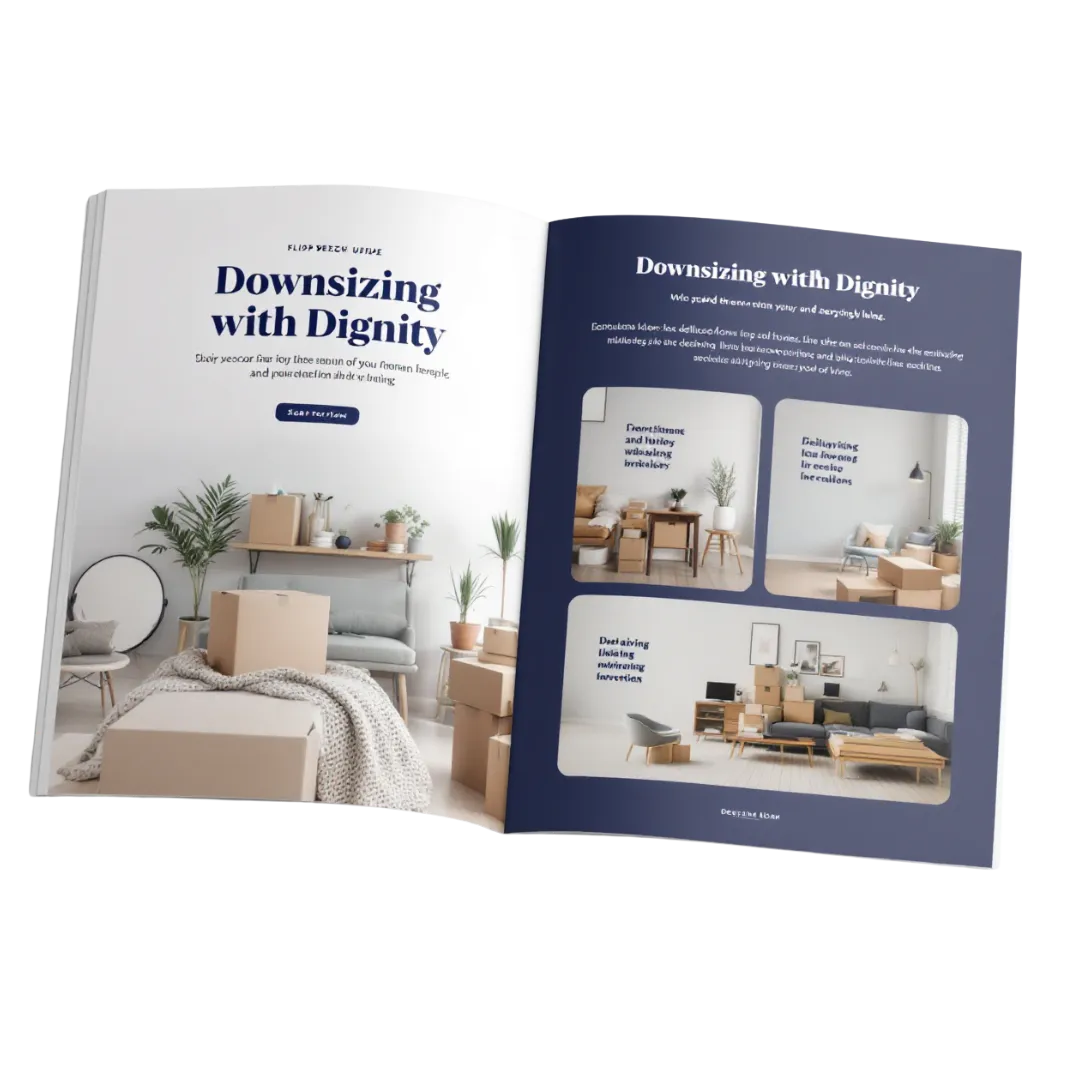Downsizing & Decluttering Services
Simplifying transitions by reducing physical and emotional clutter with compassion and care

A Lifetime of Memories in Every Drawer, Closet, and Room
After decades in your home, every item tells a story. The china cabinet that held holiday dinners. The bookshelf filled with bedtime stories read to children and grandchildren.
The workshop where projects came to life. When it's time to transition to a new chapter, how do you begin to sort through these treasures and decide what to keep, what to share, and what to let go?
"Downsizing isn't about what you're giving up—it's about making room for what matters most in this next chapter of your life. It's a process of honoring your past while creating space for your future."
The Hidden Emotional Weight of "Stuff"
For most seniors, the challenge of downsizing isn't just about physical items—it's about the memories, emotions, and identities attached to those possessions. Consider these common experiences:
The Time Capsule Effect
Items that haven't been used in years remain because they're powerful links to cherished memories and past identities.
The Gift Burden
Feeling obligated to keep items given by loved ones, even when they no longer serve a purpose in your life..
The "Someday" Inheritance
Keeping items for children or grandchildren who may not actually want or have space for these possessions.
The Letting Go Grief
Feeling that parting with possessions means losing the memories or dishonoring loved ones associated with them.
"I kept putting off downsizing because it felt overwhelming—not just physically, but emotionally. Talesa helped me see that I wasn't losing my memories by letting go of things. She guided me through honoring what was truly important while creating space for my new life. Now my home feels lighter, and so do I."
— Barbara T., 72, Menifee
A Compassionate Approach to Downsizing & Decluttering
My approach to downsizing and decluttering recognizes that this is both a practical and emotional journey.
I provide personalized support that honors your memories while helping you create a more manageable living environment:

◉ Compassionate Assessment
We'll begin with a thoughtful conversation about your goals, timeline, and specific concerns. I'll help you clarify what's most important to you and develop a personalized downsizing plan.
◉ Space Planning
If you're moving to a smaller home, we'll review the floor plan to determine exactly what will fit in your new space, helping you make informed decisions about what to keep.
◉ Sorting & Decision-Making Support
I'll work alongside you, providing gentle guidance as you sort items into categories: keep, gift to family/friends, sell, donate, or discard—always respecting that the final decisions are yours.
◉ Memory Preservation
For sentimental items you can't keep but don't want to lose entirely, I'll suggest creative solutions like photographing collections, creating memory books, or repurposing meaningful items.
◉ Distribution Coordination
I'll help coordinate the logistics of getting items to their next destination—whether that's arranging family pick-ups, connecting with estate sale professionals, or scheduling charity donations.
The Talesa Difference: Emotional Intelligence + Practical Solutions
What sets my downsizing services apart is the balance of emotional support and practical expertise. I understand that this process isn't just about clearing physical space—it's about honoring your life's journey while preparing for the next chapter.
I create a judgment-free environment where you can share stories, express feelings about cherished possessions, and make decisions at your own pace. At the same time, I provide the structure, organization, and resources to keep the process moving forward efficiently.
My clients often tell me that having a compassionate, objective third party made all the difference in transforming an overwhelming task into a manageable—and sometimes even rewarding—experience.
The Freedom of Living with Less
While downsizing can be challenging, my clients consistently report these transformative benefits:
Emotional Lightness
A sense of relief and freedom that comes from releasing the burden of excess possessions and the maintenance they require.
Enhanced Living Space
A more functional, accessible home environment that better supports your current lifestyle and needs
Reduced Stress
Less clutter means less cleaning, less maintenance, and less worry about "what will happen to all this stuff."
Joy of Giving
The satisfaction of seeing cherished items find new life with family members, friends, or those in need.
Clearer Legacy
Peace of mind knowing you've thoughtfully managed your possessions rather than leaving the burden to your children.
Freedom to Move Forward
The ability to embrace new opportunities and experiences without being anchored by possessions from the past.

Free Resource:
"Downsizing with Dignity" Guide
To help you begin your downsizing journey, I've created a comprehensive guide that includes:
Room-by-room downsizing checklist
Decision-making framework for sorting possessions
Creative ideas for preserving memories while reducing clutter
Tips for involving family members in the process
Local resources for donations, consignment, and disposal

Ready to Begin Your Downsizing Journey?
I invite you to schedule a no-obligation consultation to discuss your specific situation and how my downsizing and decluttering services can help you create a more manageable living environment while honoring your memories and treasures.
Frequently Asked Questions About
Downsizing & Decluttering
When is the right time to start downsizing?
The ideal time to begin downsizing is before you're under pressure to do so. Many seniors find that starting the process 6-12 months before a planned move gives them enough time to work through possessions thoughtfully without feeling rushed.
However, even if you don't have immediate plans to move, there are several indicators that it might be time to consider downsizing:
✔️ You're using only a portion of your home while other areas become storage spaces
✔️ Home maintenance and cleaning have become burdensome
✔️ You feel overwhelmed by the amount of "stuff" in your home
✔️ You worry about what will happen to your possessions in the future
✔️ You want to simplify your life and focus on experiences rather than things
Remember that downsizing doesn't have to happen all at once. Many of my clients find success with a gradual approach, tackling one room or category at a time over several months or even years.
The key is to begin the process while you have the energy and time to make thoughtful decisions.
How do I decide what to keep and what to let go?
This is perhaps the most challenging aspect of downsizing. I recommend using these guiding questions to help with your decision-making process:
✔️ Practical value: Do you use this item regularly? Will it serve a purpose in your next home?
✔️ Spatial reality: Will this item fit in your new space? Is it appropriate for your next living environment?
✔️ Joy factor: Does this item bring you genuine joy or comfort when you see or use it?
✔️ Legacy consideration: If you're keeping something for heirs, have you confirmed they actually want it?
✔️ Memory preservation: Can the memory attached to this item be preserved in another way (photo, story, repurposed item)?
✔️ Replacement ease: If you regretted letting this go, could it be easily replaced?
For items with strong emotional attachments, consider whether keeping the item itself is necessary to preserve the memory or honor the person associated with it.
Often, taking a photo, writing down the story, or keeping just one representative item from a collection can preserve the emotional connection while reducing physical clutter.
During our work together, I provide gentle guidance through this process, always respecting that the final decisions are yours to make.
How do I handle family heirlooms and sentimental items?
Family heirlooms and sentimental items often present the greatest downsizing challenges. Here are some approaches that have helped my clients:
✔️ Have direct conversations: Rather than assuming which items family members might want, ask them specifically. You might be surprised by what they do—and don't—treasure.
✔️ Consider early gifting: If you know certain items will go to specific people, consider giving them now so you can enjoy seeing them appreciated.
✔️ Create a "maybe" category: If you're truly torn about certain items, set them aside temporarily rather than forcing an immediate decision.
✔️ Preserve the story: Often the story behind an item is more valuable than the item itself. Consider recording the history of special pieces, either in writing or as an audio/video recording.
Keep representative pieces: Rather than keeping entire collections, select one or two pieces that best represent the whole.
✔️ Transform items: Consider creative ways to repurpose sentimental items—quilts made from old clothing, jewelry incorporating elements from heirlooms, or shadow boxes displaying small collections.
Remember that letting go of an item doesn't mean letting go of the memory or dishonoring a loved one. Sometimes the greatest gift we can give our families is thoughtfully managing our possessions rather than leaving them with difficult decisions later.
What should I do with items my children don't want?
It can be disappointing to discover that items you've been saving for your children aren't wanted, but this is increasingly common as younger generations embrace different lifestyles and design preferences. Here are some options for handling these items:
✔️ Extend the circle: Consider whether other relatives, family friends, or younger community members might appreciate these items.
✔️ Find appreciative new owners: Specialized consignment shops, online marketplaces, or collectors' groups can help items find new homes with people who will value them.
✔️ Support worthy causes: Many charitable organizations can benefit from donations of quality items, allowing your possessions to continue making a positive impact.
✔️ Document before donating: For items with family significance, consider photographing them and recording their history before letting them go.
✔️ Consider short-term storage: In some cases, younger family members may not have space now but might want items later. If appropriate, consider short-term storage for truly significant pieces.
I can help you identify the best options for your specific items, including connecting you with reputable consignment shops, auction houses, or charitable organizations that specialize in the types of items you're looking to rehome.
How long does the downsizing process typically take?
The timeline for downsizing varies significantly based on several factors:
✔️ Home size and contents: A larger home with more possessions naturally takes longer to process.
✔️ Decision-making speed: Some people can make quick decisions about their belongings, while others need more time to consider each item.
✔️ Emotional attachment level: Homes filled with highly sentimental items typically require a slower, more thoughtful approach.
✔️ Available time commitment: Working a few hours each week will extend the timeline compared to more intensive scheduling.
✔️ Number of people involved: Multiple decision-makers can sometimes extend the process, especially if there are differing opinions.
✔️ As a general guideline:
A moderate downsizing project might take 2-3 months of working several hours per week.
More extensive projects, especially for homes occupied for many decades, might take 4-6 months or longer.
If you're facing a tight deadline (such as a pending home sale), we can create an accelerated plan, often bringing in additional resources to help.
During our initial consultation, we'll discuss your specific situation and develop a realistic timeline that respects both your practical needs and emotional well-being.
How do you help with the emotional aspects of downsizing?
The emotional component of downsizing is often more challenging than the physical work. My approach includes several elements to provide emotional support:
✔️ Creating a judgment-free space: I provide a compassionate environment where all feelings about possessions are acknowledged and respected.
✔️ Honoring stories: I take time to listen to the stories behind meaningful items, recognizing that sharing these narratives is often an important part of the letting-go process.
✔️ Pacing appropriately: I'm attentive to emotional fatigue and suggest breaks when needed, ensuring the process doesn't become overwhelming.
✔️ Offering perspective: I gently help clients distinguish between the item itself and the memory or person it represents.
✔️ Suggesting creative alternatives: I provide ideas for preserving memories while reducing physical items, such as creating memory books or digital archives.
✔️ Celebrating progress: I help clients recognize and appreciate their accomplishments throughout the process.
Many clients find that having a compassionate but objective third party makes difficult decisions easier. I bring both emotional intelligence and practical expertise to create a supportive downsizing experience.
What happens to items I decide not to keep?
I help coordinate the distribution of items you decide not to keep, ensuring they find appropriate new homes. Options include:
✔️ Family distribution: I can help organize family selection days or coordinate shipping items to distant relatives.
✔️ Sales options:
Estate sales (on-site sales managed by professionals)
Consignment shops (for higher-value furniture, jewelry, and collectibles)
Online marketplaces (for items with specific collector appeal)
Auction houses (for antiques and valuable collections)
✔️ Charitable donations: I maintain relationships with various charitable organizations and can match your items with appropriate recipients.
✔️ Recycling and disposal: For items that can't be sold or donated, I arrange for environmentally responsible recycling or disposal.
I handle the logistics of these processes, including arranging for pick-ups, deliveries, and providing donation receipts for tax purposes. My goal is to minimize your stress while ensuring items are handled respectfully and responsibly.
Through my network of trusted partners, I can connect you with reputable estate sale professionals, consignment shops, and specialty buyers who offer fair value for your items.
How do your downsizing and decluttering services work, and what do they cost?
My downsizing and decluttering services are highly personalized and can be tailored to your specific needs. Here's how the process typically works:
✔️ Initial consultation: We'll meet to discuss your goals, timeline, and specific concerns. This helps me understand your unique situation and develop a customized approach.
✔️ Planning session: We'll create a detailed plan, including which areas to tackle first, how to involve family members if desired, and what resources will be needed.
✔️ Working sessions: I'll work alongside you during scheduled sessions (typically 3-4 hours each) to sort through belongings, making steady progress while respecting your decision-making pace.
✔️ Distribution coordination: I'll help arrange for the removal of items you're not keeping, whether that's coordinating with family members, donation centers, estate sale professionals, or disposal services.
✔️ Follow-up support: I remain available to answer questions and provide additional resources even after our main work is complete.
✔️ Cost: My downsizing services are offered at an hourly rate of $75-$95 per hour, depending on the complexity of the project. Most clients find that 20-40 hours of professional assistance spread over several weeks or months is sufficient for their needs.
I also offer package options for those who prefer a set price for a defined scope of work. During our initial consultation, which is complimentary, I can provide a more specific estimate based on your unique situation.
Many clients find that the investment in professional downsizing assistance is offset by the reduced stress, time savings, and often the financial returns from properly identifying valuable items that might otherwise have been overlooked.

TALESA AGUIRRE
SRES® - Senior Real Estate Specialist
CA DRE
This site and the products and services offered on this site is in no way sponsored, affiliated, endorsed or administered by, or associated with, Facebook™ or Google™. Nor have they been reviewed tested or certified by Facebook™.
You understand that you are providing your information to Talesa Aguirre - Senior Transition Specialist and not to Facebook™ or Google™. The information you provide will only be used by Talesa Aguirre - Senior Transition Specialist.
© Copyright 2025. Talesa Aguirre - Real Estate Agent. All Rights Reserved. Privacy Policy | Terms and Conditions